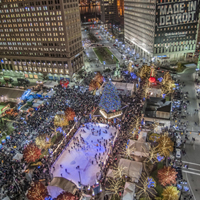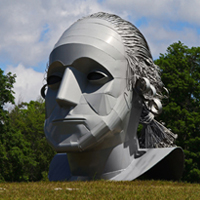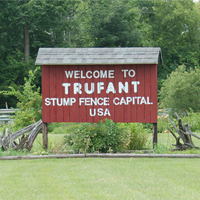Creative Placemaking is applicable to all types and sizes of communities
While some communities may be unaware of the focus of arts and culture in their area, placemaking can be a way to highlight the diverse ways that places of all sizes can find their unique assets and give them an identity.

While some communities may be unaware of the focus of arts and culture in their area, placemaking can be a way to highlight the diverse ways that places of all sizes can find their unique assets and give them an identity. From large, high-traffic places to small rural towns and trails, Creative Placemaking techniques allow communities to add to the sense of place through public art, such as sculptures, murals and more. Showcasing the arts in a community is important to highlight the importance of the creative industry in the American economy, where 3.9% of all businesses and 1.9% of all employees nationally are employed (as of January 2015).
While not every community includes representation from every arts discipline, most communities still have music teachers, art teachers, painters, dance instructors, and even children who are creative and can take the lead on Creative Placemaking projects. More recently, the creative industry has spilled over into the realm of news media, music and video recordings, and even social media, proving that there is generally no shortage of creative people, they just need to acquire the leadership and funding to make their project ideas a reality.
 Creative Placemaking can be used for communities of all sizes, and for projects that are representative of different art media. For example, Campus Martius, a large public square in Detroit’s Central Business District, is host to film festivals, weekend concerts, musical programs, and other arts and cultural events year-round. Alternatively, ArtPrize in Grand Rapids, an international art competition, occurs for 19 days every year to showcase new artwork from around the world. Regardless if these Creative Placemaking projects are short-term or permanent they still have been successful in energizing their communities with artistic expression that leads to the creation of engaging quality places where people want to visit, socialize and explore.
Creative Placemaking can be used for communities of all sizes, and for projects that are representative of different art media. For example, Campus Martius, a large public square in Detroit’s Central Business District, is host to film festivals, weekend concerts, musical programs, and other arts and cultural events year-round. Alternatively, ArtPrize in Grand Rapids, an international art competition, occurs for 19 days every year to showcase new artwork from around the world. Regardless if these Creative Placemaking projects are short-term or permanent they still have been successful in energizing their communities with artistic expression that leads to the creation of engaging quality places where people want to visit, socialize and explore.

Creative Placemaking can also be used in small communities or rural areas, and something as simple as a single statue can help create a sense of place in a remote area. For example, in northern Michigan, the U.S. Route 23 ARTrail brings attention to highlighting the arts, culture, natural resources and historical sites for various small towns along the corridor. One sculpture, titled “Washington,” along the corridor creates a destination for tourists to stop and visit, and creates opportunities to explore the surrounding area.
 Creative Placemaking can also be used to highlight a unique form of art that may be specific to a small community or region. In the Village of Trufant, MI, stump fences were once a way to reuse a waste product; however, over time, they have become a form of indigenous art. This art form has also been turned into a branding technique for the small village, which has since stated that it is “Stump Fence Capital USA.”
Creative Placemaking can also be used to highlight a unique form of art that may be specific to a small community or region. In the Village of Trufant, MI, stump fences were once a way to reuse a waste product; however, over time, they have become a form of indigenous art. This art form has also been turned into a branding technique for the small village, which has since stated that it is “Stump Fence Capital USA.”
The Placemaking Guidebook discusses Creative Placemaking in much greater detail, especially Chapter 11, which includes more information about ArtPrize, the “Washington” sculpture and the Trufant Stump Fences). More information on Campus Martius is also available in Chapter 1.
To learn more, order your free copy today at: Placemaking Guidebook.
Photos courtesy of the Downtown Detroit Partnership (Campus Martius); Kurt H. Schindler, AICP, MSU Extension (Village of Trufant welcome sign); and Moran Iron Works (“Washington” sculpture).



 Print
Print Email
Email




